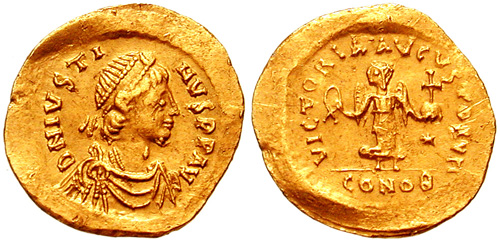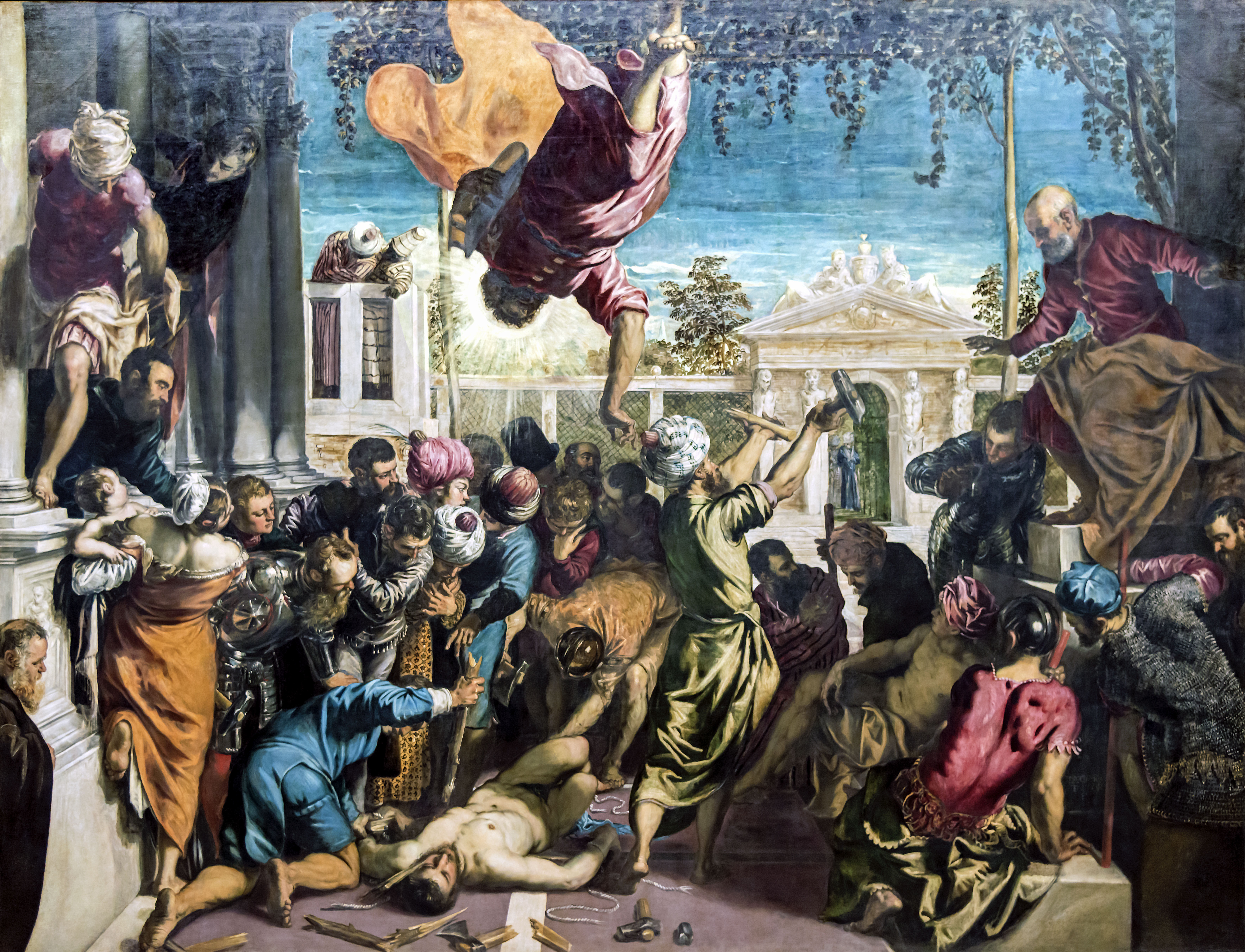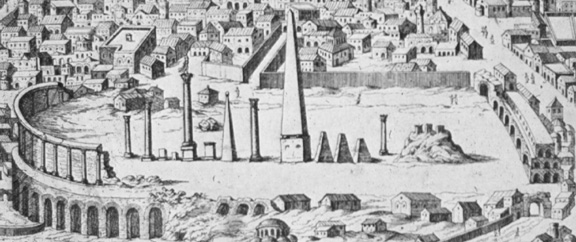|
Basilides (patricius)
Basilides ( el, ) was a Byzantine Empire, Byzantine official who held the office of ''magister officiorum'' during the reign of Emperor Justinian I (r. 527–565). He was a member of the commission responsible for forming the ''Corpus Juris Civilis''. . On February 13, 528, Basilides was appointed as a member of the commission preparing the ''Corpus Juris Civilis'', serving under Tribonian. Their work was completed in 529. While this is the first chronological mention of him, the text of his appointment mentions him as being already a ''vir excellentissimus'' ("most excellent man"), a former Praetorian prefecture of the East, praetorian prefect of the East and a patrikios, patrician. His title of praetorian prefect has been suggested to be honorific, as modern historians find it strange that Basilides could have served in this high-ranking position prior to holding lower offices.. On April 7, 529, official texts mention Basilides as the serving Praetorian prefecture of Illyricum, p ... [...More Info...] [...Related Items...] OR: [Wikipedia] [Google] [Baidu] |
Byzantine Empire
The Byzantine Empire, also referred to as the Eastern Roman Empire or Byzantium, was the continuation of the Roman Empire primarily in its eastern provinces during Late Antiquity and the Middle Ages, when its capital city was Constantinople. It survived the fragmentation and fall of the Western Roman Empire in the 5th century AD and continued to exist for an additional thousand years until the fall of Constantinople to the Ottoman Empire in 1453. During most of its existence, the empire remained the most powerful economic, cultural, and military force in Europe. The terms "Byzantine Empire" and "Eastern Roman Empire" were coined after the end of the realm; its citizens continued to refer to their empire as the Roman Empire, and to themselves as Romans—a term which Greeks continued to use for themselves into Ottoman times. Although the Roman state continued and its traditions were maintained, modern historians prefer to differentiate the Byzantine Empire from Ancient Rome ... [...More Info...] [...Related Items...] OR: [Wikipedia] [Google] [Baidu] |
Nika Riots
The Nika riots ( el, Στάσις τοῦ Νίκα, translit=Stásis toû Níka), Nika revolt or Nika sedition took place against Byzantine Emperor Justinian I in Constantinople over the course of a week in 532 AD. They are often regarded as the most violent riots in the city's history, with nearly half of Constantinople being burned or destroyed and tens of thousands of people killed. Background The ancient Roman Empire, Roman and Byzantine Empire, Byzantine empires had well-developed associations, known as ''Deme#Later usage, demes'', which supported the different factions (or teams) to which competitors in certain sporting events belonged, especially in chariot racing. There were initially four major factions in chariot racing, differentiated by the colour of the uniform in which they competed; the colours were also Byzantine dress, worn by their supporters. These were the Blues (''Veneti''), the Greens (''Prasini''), the Reds (''Russati''), and the Whites (''Albati''), althou ... [...More Info...] [...Related Items...] OR: [Wikipedia] [Google] [Baidu] |
Zooras
Zoora (Syriac: ܙܥܘܪܐ, ''Zeʿora''; Greek Ζωόρας, ''Zooras'') was a Syrian Miaphysite monk and stylite in the Roman Empire. He moved to Constantinople in the early 530s and was condemned at the Council of Constantinople in 536. He died a few years later. Zoora's life is known mainly from the hagiography written by his contemporary, John of Ephesus, who probably met him in Constantinople around 536. The first part of it is missing. Zoora hailed from the region around Amida. He was short in stature and his name means "small" in Syriac. He received his spiritual training under a certain Habib. Sometime before the Hunnic invasion of 515, during the reign of Anastasius I, he ascended a pillar. Zoora remained a stylite through at least to the end of the reign of Justin I (died 527). He was forced to descend by the Chalcedonians. He went to Constantinople early in the reign of Justin's successor, Justinian I. By this time he was renowned locally and arrived in Constantino ... [...More Info...] [...Related Items...] OR: [Wikipedia] [Google] [Baidu] |
Excubitors
The Excubitors ( la, excubitores or , , i.e. 'sentinels'; transcribed into Greek as , ) were founded in as an imperial guard unit by the Byzantine emperor Leo I the Thracian. The 300-strong force, originally recruited from among the warlike mountain tribe of the Isaurians, replaced the older as the main imperial bodyguard. The Excubitors remained an active military unit for the next two centuries, although, as imperial bodyguards, they did not often go on campaign. Their commander, the count of the Excubitors (, ), soon acquired great influence. Justin I was able to use this position to rise to the throne in 518, and henceforth the counts of the Excubitors were among the main political power-holders of their day; two more, Tiberius II Constantine and Maurice, rose to become emperors in the late 6th century. In the late 7th century, the Excubitors appear to have degenerated into a parade-ground formation, and fade from the record as a corps. Individual seals of office attest to ... [...More Info...] [...Related Items...] OR: [Wikipedia] [Google] [Baidu] |
Constantinople
la, Constantinopolis ota, قسطنطينيه , alternate_name = Byzantion (earlier Greek name), Nova Roma ("New Rome"), Miklagard/Miklagarth (Old Norse), Tsargrad ( Slavic), Qustantiniya (Arabic), Basileuousa ("Queen of Cities"), Megalopolis ("the Great City"), Πόλις ("the City"), Kostantiniyye or Konstantinopolis ( Turkish) , image = Byzantine Constantinople-en.png , alt = , caption = Map of Constantinople in the Byzantine period, corresponding to the modern-day Fatih district of Istanbul , map_type = Istanbul#Turkey Marmara#Turkey , map_alt = A map of Byzantine Istanbul. , map_size = 275 , map_caption = Constantinople was founded on the former site of the Greek colony of Byzantion, which today is known as Istanbul in Turkey. , coordinates = , location = Fatih, İstanbul, Turkey , region = Marmara Region , type = Imperial city , part_of = , length = , width ... [...More Info...] [...Related Items...] OR: [Wikipedia] [Google] [Baidu] |
Pope Agapetus I
Pope Agapetus I (489/490 – 22 April 536) was the bishop of Rome from 13 May 535 to his death. His father, Gordianus, was a priest in Rome and he may have been related to two previous popes, Felix III and Gregory I. In 536, Agapetus traveled to Constantinople at the behest of King Theodahad of the Ostrogoths and unsuccessfully tried to persuade Emperor Justinian I to call off a Byzantine invasion of the Ostrogoth kingdom. While in Constantinople, Agapetus also deposed the patriarch Anthimus I and personally consecrated his successor who is Mennas of Constantinople. Four of Agapetus’ letters from this period have survived: two addressed to Justinian, one to the bishops of Africa, and one to the Bishop of Carthage. Agapetus was canonized in both the Catholic and Orthodox traditions; his feast day is 20 September in the former and 22 April in the latter. Family Agapetus was born in Rome, although his exact date of birth is unknown. He was the son of Gordianus, a Roman pries ... [...More Info...] [...Related Items...] OR: [Wikipedia] [Google] [Baidu] |
John Of Ephesus
John of Ephesus (or of Asia) ( Greek: Ίωάννης ό Έφέσιος, c. 507 – c. 588) was a leader of the early Syriac Orthodox Church in the sixth century and one of the earliest and the most important historians to write in Syriac. John of Ephesus was a bishop, but John was more important than other bishops and what sets him apart from most others is the fact that he was a historian and a writer. He was also a political man and would often follow his own path. John was seen as a great writer and covered important aspects of events in history, and one of these important events was the plague, and John has one of the only first-hand accounts of the plague. He was also alive in what has been called the worst year ever. Life Born at Amida (modern Diyarbakır in southeastern Turkey) about 507, he was there ordained as a deacon in 529 by John of Tella at Zuqnin Monastery, When John was a teenager, he moved to Amida, located on the Tigris River. Amida was in the providence of A ... [...More Info...] [...Related Items...] OR: [Wikipedia] [Google] [Baidu] |
Roman Consul
A consul held the highest elected political office of the Roman Republic ( to 27 BC), and ancient Romans considered the consulship the second-highest level of the ''cursus honorum'' (an ascending sequence of public offices to which politicians aspired) after that of the censor. Each year, the Centuriate Assembly elected two consuls to serve jointly for a one-year term. The consuls alternated in holding '' fasces'' – taking turns leading – each month when both were in Rome and a consul's ''imperium'' extended over Rome and all its provinces. There were two consuls in order to create a check on the power of any individual citizen in accordance with the republican belief that the powers of the former kings of Rome should be spread out into multiple offices. To that end, each consul could veto the actions of the other consul. After the establishment of the Empire (27 BC), the consuls became mere symbolic representatives of Rome's republican heritage and held very little ... [...More Info...] [...Related Items...] OR: [Wikipedia] [Google] [Baidu] |
Miracle
A miracle is an event that is inexplicable by natural or scientific lawsOne dictionary define"Miracle"as: "A surprising and welcome event that is not explicable by natural or scientific laws and is therefore considered to be the work of a divine agency." and accordingly gets attributed to some supernatural or praeternatural cause. Various religions often attribute a phenomenon characterized as miraculous to the actions of a supernatural being, (especially) a deity, a magician, a miracle worker, a saint, or a religious leader. Informally, English-speakers often use the word ''miracle'' to characterise any beneficial event that is statistically unlikely but not contrary to the laws of nature, such as surviving a natural disaster, or simply a "wonderful" occurrence, regardless of likelihood (e.g. "the miracle of childbirth"). Some coincidences may be seen as miracles. A true miracle would, by definition, be a non-natural phenomenon, leading many writers to dismiss miracles as p ... [...More Info...] [...Related Items...] OR: [Wikipedia] [Google] [Baidu] |
Hagia Sophia
Hagia Sophia ( 'Holy Wisdom'; ; ; ), officially the Hagia Sophia Grand Mosque ( tr, Ayasofya-i Kebir Cami-i Şerifi), is a mosque and major cultural and historical site in Istanbul, Turkey. The cathedral was originally built as a Greek Orthodox church which lasted from 360 AD until the conquest of Constantinople by the Ottoman Empire in 1453. It served as a mosque until 1935, when it became a museum. In 2020, the site once again became a mosque. The current structure was built by the eastern Roman emperor Justinian I as the Christian cathedral of Constantinople for the state church of the Roman Empire between 532 and 537, and was designed by the Greek geometers Isidore of Miletus and Anthemius of Tralles. It was formally called the Church of the Holy Wisdom () and upon completion became the world's largest interior space and among the first to employ a fully pendentive dome. It is considered the epitome of Byzantine architecture and is said to have "changed the history o ... [...More Info...] [...Related Items...] OR: [Wikipedia] [Google] [Baidu] |
Hippodrome Of Constantinople
Sultanahmet Square ( tr, Sultanahmet Meydanı) or the Hippodrome of Constantinople ( el, Ἱππόδρομος τῆς Κωνσταντινουπόλεως, Hippódromos tēs Kōnstantinoupóleōs; la, Circus Maximus Constantinopolitanus; tr, Hipodrom) is a square in Istanbul, Turkey. Previously, it was a circus that was the sporting and social centre of Constantinople, capital of the Byzantine Empire. The word ''hippodrome'' comes from the Greek ''hippos'' (), horse, and ''dromos'' (δρόμος), path or way. For this reason, it is sometimes also called ("Horse Square") in Turkish. Horse racing and chariot racing were popular pastimes in the ancient world and hippodromes were common features of Greek cities in the Hellenistic, Roman and Byzantine eras. History and use Construction Although the Hippodrome is usually associated with Constantinople's days of glory as an imperial capital, it actually predates that era. The first Hippodrome was built when the city was ... [...More Info...] [...Related Items...] OR: [Wikipedia] [Google] [Baidu] |
Quaestor Sacri Palatii
The ''quaestor sacri palatii'' ( gr, κοιαίστωρ/κυαίστωρ τοῦ ἱεροῦ παλατίου, usually simply ), in English: Quaestor of the Sacred Palace, was the senior legal authority in the late Roman Empire and early Byzantium, responsible for drafting laws. In the later Byzantine Empire, the office of the ''quaestor'' was altered and it became a senior judicial official for the imperial capital, Constantinople. The post survived until the 14th century, albeit only as an honorary title. Late Roman ''quaestor sacri palatii'' The office was created by Emperor Constantine I (), with the duties of drafting of laws and the answering of petitions addressed to the emperor. Although he functioned as the chief legal advisor of the emperor and hence came to exercise great influence, his actual judicial rights were very limited.. Thus from 440 he presided, jointly with the praetorian prefect of the East, over the supreme tribunal in Constantinople which heard appeals ( ... [...More Info...] [...Related Items...] OR: [Wikipedia] [Google] [Baidu] |




.jpg)

